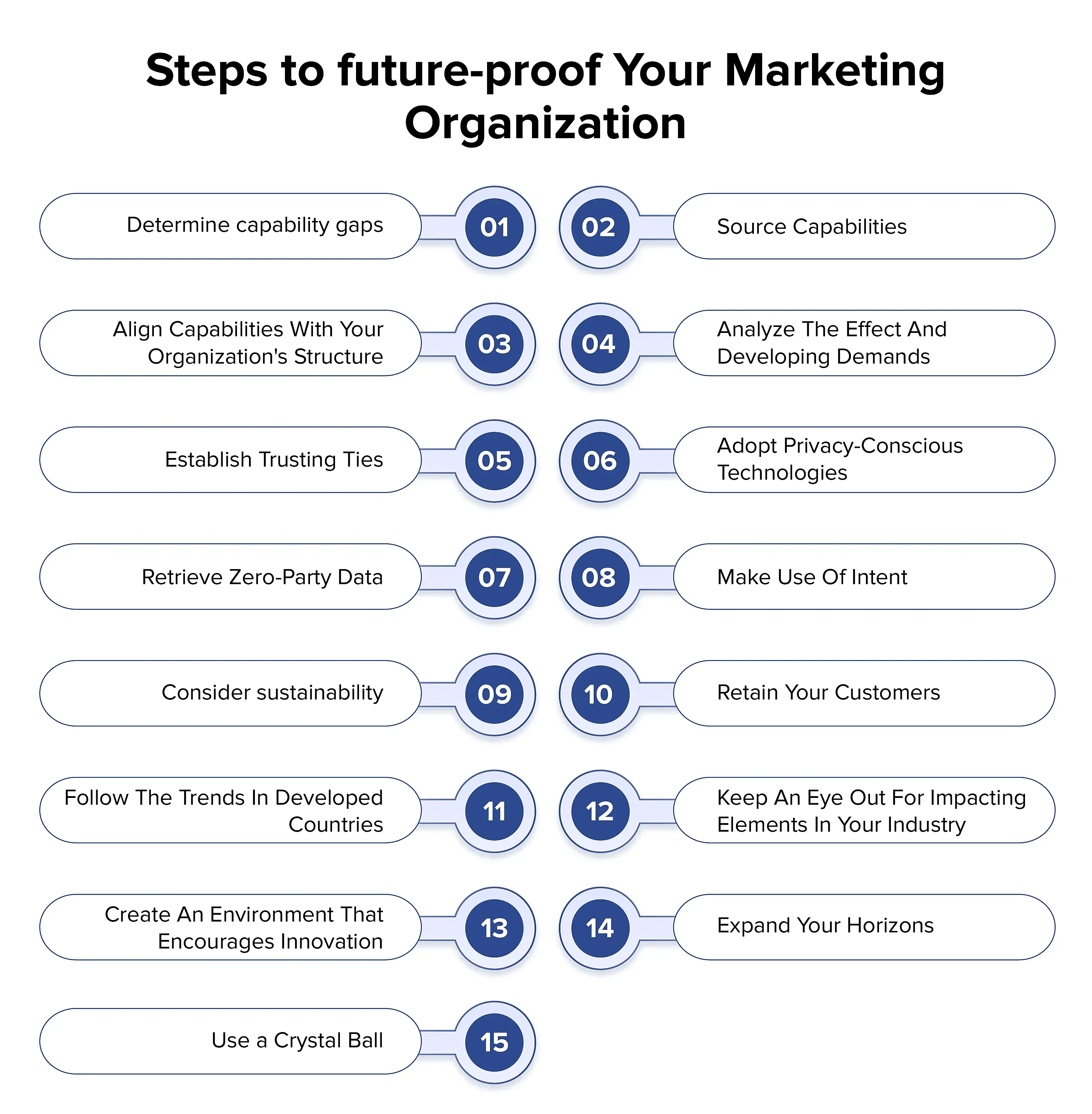
- What Is Future-proofing?
- Future-proofing Technology In Modern Marketing Organizations: Key Insights & Stats
- Why Is Future-Proofing Your Business Important?
-
Steps to Future-proof Your Marketing Organization
- Determine Capability Gaps
- Source Capabilities
- Align Capabilities With Your Organization's Structure
- Analyze The Effect And Developing Demands
- Establish Trusting Ties
- Adopt Privacy-Conscious Technologies.
- Retrieve Zero-Party Data
- Make Use Of Intent
- Consider Sustainability
- Retain Your Customers
- Follow The Trends In Developed Countries
- Keep An Eye Out For Impacting Elements In Your Industry.
- Create An Environment That Encourages Innovation
- Expand Your Horizons
- Use a Crystal Ball
- The Gist Of The Article

The way people work is rapidly changing, from project-based employment to a lack of structure. Organizations that plan for the post-pandemic environment are more likely to deliver value—even in the face of uncertainty.
Unfortunately, while the answer was yes for some firms, it was a no for others. But why did some businesses fail while others persisted? And what can already-existing companies do to secure their continued success in the face of future uncertainty? One solution is future-proofing or setting up your company to succeed even in less-than-ideal circumstances or when the unexpected occurs.
According to a recent article from American Express, future-proofing your company doesn't have to be challenging, time-consuming, or expensive, particularly if you incorporate it into your routine business planning. However, future-proofing can offer you safety and financial stability while negotiating the ambiguous and always-shifting business environment.
This article will provide tips for becoming ready for known and unknowable issues in the ensuing sections. But first, let’s see what future-proofing is and why it is important in modern marketing organizations.
What Is Future-proofing?
future-proofing is strategic planning that analyzes a company's long-term well-being and mission to promote success for years. Different best mobile app marketing companies will take different approaches to future-proof technology of their brands and prepare for future events such as global economic shifts and technological breakthroughs. Some examples of future-proofing in the modern marketing organization include committing to a customer-centric, particular mission statement, adopting new technology, forging strong alliances, and soliciting feedback from stakeholders.
Future-proofing Technology In Modern Marketing Organizations: Key Insights & Stats
- According to insight shared by McKinsey & Company based on conversations with industry professionals and experts, it is estimated that Relationship Managers spend between 60-70% of their time on non-revenue-generating activities amid rising regulatory and compliance obligations.
- Business executives are worried about the future of their companies. According to KPMG, 74% of CEOs are concerned about a new startup challenging their business model.
- According to Cerulli & Associates' recent research, 94% of practice management professionals feel that limited technology integration poses productivity issues for their firms.
- According to 57% of advisors, the most critical technical pain factor is a lack of integration between their primary systems.
- According to McKinsey, just 6% of CEOs are fully satisfied with the innovation their company brings in.
- Recent Deloitte findings show that 51% of financial advisors consider leaving a company to leverage better technology.
Why Is Future-Proofing Your Business Important?
Today, future-proofing is critical. Modern marketing organizations that are proactive and consider future-proofing might use technology to navigate volatility. And here's a sneak peek to know the reasons to future-proof your business:
Interactions with Customers
With continuously changing customer expectations and the epidemic, remote contacts and customer recognition must increasingly occur digitally. Adapting and nurturing new tactics for enhanced client interactions, acquisition, and revenue growth is critical.
The Scalability of Technology
Businesses currently operate in a volatile environment, with the possibility of increased volatility in the future due to natural disasters, supply chain disruptions, and financial crises. Business leaders who choose scalable technology solutions for such future scenarios will gain a competitive advantage.
Technological Flexibility and Business Agility
Business agility is essential nowadays. It enables company executives to be more sensitive to change, accelerate time to market, and reduce costs without sacrificing quality.
Furthermore, businesses must prepare to utilize flexible technologies to profit from always having relevant technology. Companies can also learn how to use AI and machine learning in existing apps.
Firms ' capabilities can improve with business services like BI and financial management dependent on such technologies. They can also use the best accounting apps to streamline bookkeeping in 2023.
Furthermore, businesses can also follow the cybersecurity tips to secure privacy. It is critical to understand the significance of appropriate enterprise security. And company data should be inspected so that "future-proofing" can meet long-term security needs.
Employee Adaptability
With ever-changing market conditions, business executives are continuously working on increasing resilience, and one guaranteed strategy is to upskill staff and new hires. Companies must continually learn and concentrate on reskilling possibilities to keep their employees' skill sets evolving. Such proactive expenditures in employee development can boost engagement.
Steps to Future-proof Your Marketing Organization
Follow these steps to create a flexible modern marketing organizational structure that can deliver effective key marketing strategies while reacting to disruption in the future-proof your business goal.

1. Determine Capability Gaps
While you may be tempted to adopt a complete reorganization based on what your peers are doing, the reality is that there is no one-size-fits-all organizational architecture. Instead, begin by identifying the skills and capabilities required to meet your strategic objectives:
Create a capability evaluation
Consider the talents your team will require to execute your strategic goal and brainstorm with leadership. Marketing capabilities can and should differ depending on the organization. An inbound content and the essential components of marketing plan, for example, will necessitate one set of capabilities, while a significant investment in paid media capabilities will necessitate another.
Create scenarios for mid- and long-term organizational transformations
Consider the following: "What impact would a new product have on our content marketing strategy?" Make gaps in your capabilities plan to account for possible circumstances.
Capabilities in terms of resources and review
Determine which capabilities you have access to and where they are located. Then, concentrate on any gaps, misalignments, or lack of capacity. Make careful to prioritize talents over inflexible job roles. Marketers frequently have abilities and skills beyond their official job descriptions or titles.
2. Source Capabilities
How will you fill gaps in capabilities or capacity? Understand the advantages and disadvantages of developing, acquiring, or partnering to source capabilities based on your sourcing goal. Developing talent in-house, for example, gives you the best control over talent management. However, it takes time and affects company continuity if attrition occurs.
Create a scorecard to understand how specific competencies or skills support strategic objectives to produce business outcomes when you are ready to design a resourcing plan.
3. Align Capabilities With Your Organization's Structure
Adding skills or redeploying talent should be done in a modern marketing organizational structure. Adjustments frequently necessitate modifying operating models and governance rather than completely reorganizing. Consider adding the needed skills while having the least influence on the business.
This reduces disruption and the possibility of change weariness. "Assess the relative strategic importance and difficulty of developing the capability," Abatangle states. "Take the entire marketing organization into account." There may be varying levels of operational maturity for a given capacity in big, matrixed, or distributed teams."
ALSO READ: The 7 Ps of Marketing - A Pocket Guide for Entrepreneurs
4. Analyze The Effect And Developing Demands
Finally, remember that your organization's design must alter as your strategy evolves. Consider it a continuous process to guarantee that your team's capabilities continue to evolve to support the strategy.
Set goals and benchmarks for the organizational changes you are adopting. Create success measures to track the influence on business outcomes. For example, if you need to increase sales enablement capabilities and implement an account-based marketing strategy, you should be able to monitor the impact of your organizational changes at both the tactical and strategic levels. Tactical metrics may include the number of marketing-qualified accounts, engagement rate, or pipeline velocity. Customer acquisition cost, lifetime value, or revenue are all examples of strategic KPIs.
It is also critical to assess the impact of capability development on the organization. Employee satisfaction, engagement, readiness, skill assessments, and execution speed can all be used to determine how well the capacity has been integrated into the team.
5. Establish Trusting Ties
For 70% of modern customers, trust is the most crucial aspect of their decision-making process. The numerous ways trust may impact your business are mentioned in the "Rise of the Responsible Marketer" report.
Direct, truthful, and straightforward communication is essential to developing a strong rapport with your audience. Consistent efforts must be made across all channels and platforms, such as establishing clear and accessible privacy guidelines and outlining why and how personal data is being collected.
You must develop a customer journey that reinforces your status as a trustworthy brand from the first interaction. The first actions you must take to demonstrate your commitment to responsible marketing are third-party reviews on your homepage and explicit and transparent data collection during email newsletter sign-ups.
6. Adopt Privacy-Conscious Technologies.
Businesses worldwide must think more carefully about data privacy rights in light of the privacy enhancements released by digital giants Apple and Google. This phenomenon is not brand-new as we are already aware of how mobile apps are changing our lives. Laws such as the GDPR and CCPA have already influenced marketers' perception of customer data. However, as further privacy changes lurk, you must consider how your marketing stack will meet escalating needs.
A platform that allows you to track consent - what and when clients agreed to receive your marketing - and has ISO 27001, ISO 27701, and ISO 14001 accreditations ensures that we take privacy seriously and are already planning the next big thing.
7. Retrieve Zero-Party Data
Self-reported information is what zero-party data is. It's readily and openly shared with you since you've gained your audience's trust. But what is the significance of zero-party data?
With the eventual demise of third-party cookies and an ever-changing privacy landscape, marketers must devise new methods of gathering information about their target audience. To develop conversion-driven experiences and journeys, you must first understand what motivates users. Zero-party data is, by its very nature, reliable because it is self-reported. What your target audience wants, why they want it, and how they want to receive it are all revealed through information directly from them.
In the end, gathering zero-party data will increase your marketing strategy's efficiency and produce stronger outcomes.
8. Make Use Of Intent
Marketers must develop new strategies to connect with consumers at pivotal times in their lives in the new environment when consumers have greater control over their data privacy and third-party cookies are being phased out.
Your wisdom has never been more priceless than it is right now. Audience intelligence and intent data can assist you in determining who is ready to convert and who is required to lead nurturing activities. Data-driven marketing initiatives will increase your results dramatically. Using RFM audience modeling, lead scoring, and tracking high-intent pages, you will be able to target segments with hyper-relevant content.
Finally, leveraging consumer intent can bring more high-quality prospects into your marketing funnels, allowing you to achieve more of your marketing objectives.
9. Consider Sustainability
Sustainability is more than a buzzword. It's there, important, and changing how the game is played.
You must implement adjustments today that will have an effect tomorrow as your business gets ready for the future. Greenwashing is unacceptable to today's environmentally sensitive audiences. You must consider the entire impact of your business, not just the customer-facing aspects. Sustainable packaging is excellent and vital, but incorporating it into your brand story will not have the same lasting impact.
To be perceived as real and trustworthy, you must demonstrate your commitment to sustainability in everything you do.
10. Retain Your Customers
According to Dotdigital's Global benchmarking report, email unsubscribe rates were increasing by 7.6%, while new contact generation declined by more than 8%.
List growth is an excellent way to gauge marketing success, but the size of your marketing list does not always correspond to the number of engaged contacts. To future-proof your marketing, consider your customer retention strategies. Not only loyalty programs, either. What about your brand will entice consumers to buy more products? How will you maintain the interest of your audience over a longer length of time?
Your objectives will change based on your B2B marketing organization. An e-commerce company may want repeat transactions; non-profits may track annual donations or volunteer hours; and B2Bs may focus on contract renewal. Ultimately, they all rely on recurring business, which should be a primary goal of any competent marketer.
ALSO READ: Mobile App Marketing Campaigns to Boost User Retention in 2023
11. Follow The Trends In Developed Countries
Of all the tactics, this one is the easiest. You must stay current with developments in your industry in other wealthy nations if you want to stay ahead of the competition. Where can I find this information? On numerous blogs and websites. Even better, you may create a Google Alert for a certain subject.
As a result, if you sell solar panels, keep a watch on developments in China or Germany related to solar energy. A few years ago, Uber was founded in the United States, and when it expanded to India, it completely changed the cab hiring market there.
Similarly, it was expected that things would change in developing nations like India when video and audio streaming became common in the United States. As a result, companies such as BigFlix (DVD renting) had to reconsider their long-term strategy. They quickly ceased shipping DVDs offline and switched to an online business.
ALSO READ: Exploring the Evolving Tech World through the Latest Trends in Technology
12. Keep An Eye Out For Impacting Elements In Your Industry.
You must be aware of your surroundings to future-proof your startup. Even if it has nothing to do with your B2B marketing organization, you still need to be informed of what is happening around you.
We've all seen how cell phones decimated the photographic sector. Kodak, the camera and film manufacturer, was once worth a billion dollars. It failed to recognize the future, and the 130-year-old corporation declared bankruptcy in 2012. Aside from the camera, cell phones are responsible for the demise of other successful goods such as music players, handy cameras, portable gaming consoles such as the PSP, GPS systems, paper maps, and telephone directories such as Yellow Pages.
ProfitBooks, for example, believes that businesses will access their business data from any internet-enabled device, so we purposefully moved away from offline software and established cloud accounting software. We provide unparalleled assistance in future-proofing your business!
Consumer preferences changed substantially as internet speeds improved, affecting many enterprises. You must keep an eye out for such influencing elements that can indirectly impact your organization.
13. Create An Environment That Encourages Innovation
Future-proofing your firm is not feasible, but we can come close. You cannot constantly succeed by following the leaders; you must innovate at some point to remain competitive. Innovation is difficult, and you may fail multiple times before hitting the target, but once you do, you will be miles ahead of your competitors.
To build an innovative culture, you must first create a conducive environment. Give your employees the flexibility to experiment, send them to tech events and conferences in your field, and reward them for their efforts.
14. Expand Your Horizons
While organizations specializing in one area generally thrive, the ancient adage "don't put all your eggs in one basket" also applies to future prosperity. Returning to the women's clothes business as an example, it is clear from the vision statement that women's clothing is the core offering. However, if the brand wants to assist women of all sizes to feel good in their clothes, they could do much more, such as offering styling services or creating films or courses to boost self-confidence.
15. Use a Crystal Ball
No one can foretell the future, but by observing current trends, you might be able to get a good notion. For instance, many companies realized that the work-from-home (WFH) arrangements during the epidemic represented a fundamental, long-lasting change in how work is done. They used that knowledge to improve or create new products to assist businesses in meeting the issues that arose due to the pivot. future-proofing entails being willing to innovate based on well-informed ideas.
The Gist Of The Article
Now, you must know how to future-proof your marketing organization. The nature of labor is being profoundly altered by technology. However, several of the best mobile app marketing agencies approaches to labor planning and HR management haven't altered much in the last two decades. Companies must transition into the digital era as they rebuild their workforces in the aftermath of Covid-19. Talent management and planning must become more strategic, holistic, rigorous, and data-driven. Companies that rebuild using old analog procedures will be outperformed by more foresighted competition. Companies must begin future-proofing their businesses today, given how long it will take to establish a winning talent pool.
Things change quickly in today's economic environment, and even a successful company cannot ensure its survival if it is unprepared for the future. A future-proof marketing organization recognizes trends and is willing to adopt change when it is required. Consider the seven suggestions above, and your organization will be on the right track. You can future-proof your firm and stay ahead of the competition using the abovementioned ideas.
Frequently Asked Questions
-
How to organize a marketing department?
-
What is the role and importance of a marketing organization?
-
How to future-proof your marketing organizational chart?
-
Which types of marketing organizations need future-proofing strategies:
-
What is a marketing organizational chart?
-
What are some of the organization's marketing examples?



















